#perilous trail quest
Text

Who else stopped breathing at this point in the event?
👌Peak storytelling👌
I always come back to Genshin for Xiao (and Albedo). Their backstories and personalities are the most intriguing in my opinion.
I really wanted to hug Xiao in this event, too bad the game doesn’t let us. T-T
#genshin impact#genshin xiao#genshin lumine#perilous trail quest#xiao’s self-sacrifice#the music was epic too#aaaa best event yet#xiao is best boi#fanart#zsocca#zsocca55#xiaolumi
814 notes
·
View notes
Text
I can’t believe I was almost crying at a cutscene of a video game because my favorite character is a self sacrificing idiot 😫
1 note
·
View note
Photo
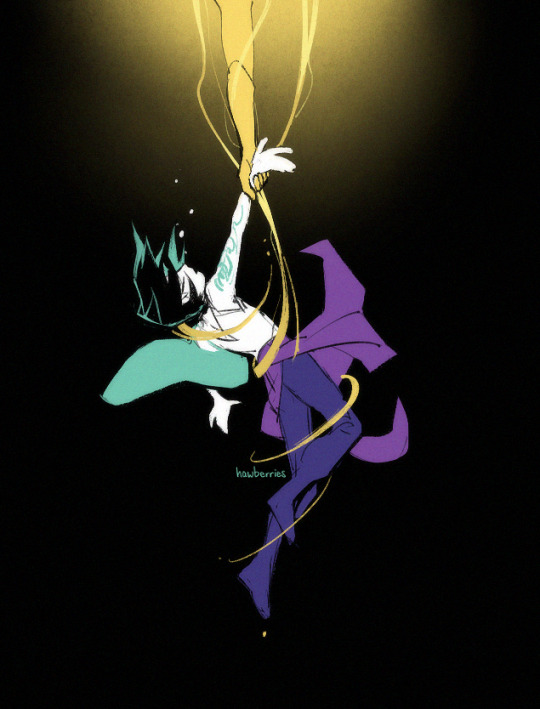
not yet
[image is image is a stylised drawing of Xiao falling through a dark void; his face is hidden, but he's weeping. A golden arm catches his wrist and lifts him, golden threads dropping from the top of the image to twine around him.]
#I PLAYED THE 2.7 QUEST PERILOUS TRAIL AND NOW IM POSSESSED. AGAIN. BY THE ZHONGXIAOS#GETTING XIAO BRAIN DISEASE IN 2023… ITS MORE LIKELY THAN YOU THINK#genshin impact#xiao#zhongxiao#fanart#people!
4K notes
·
View notes
Text




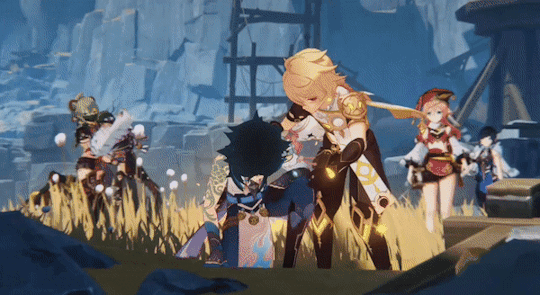
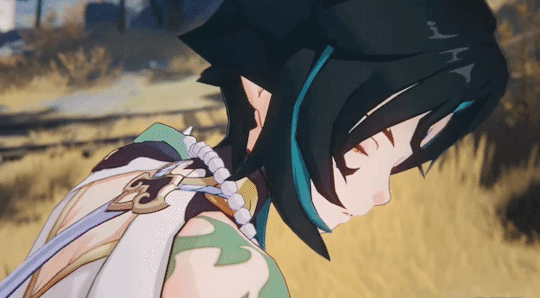
Papa Zhongli to the rescue ☆
#genshin impact#genshin gifs#genshin impact gifs#xiao#xiao layouts#zhongli#perilous trail#genshin story quest#adeptus xiao
10K notes
·
View notes
Text

Squad it’s four pm time for a group nap
#snore mimimi#itto was such a riot in that quest shoutout to little dude and floating lavender melon#itto#arataki itto#paimon#genshin impact xiao#xiao#perilous trail#genshin impact#genshin impact fanart#tumblr user butter posting consistently instead of posting once and disappearing for a month!?#my doodles
2K notes
·
View notes
Text
How evil is arlecchino and what is she cooking
As of 4.2, I’m really curious what they’re planning with Arlecchino as a character, especially as a villain/antagonist/morally dubious character, and how far/which direction they may go with that
Intuitively my impression is we’ll see her do something way more “villainous” than she presents herself as being for majority of Fontaine’s AQ in front of us right—(which isn’t a surprise given that, you know, Arlecchino nor the House of Hearth have never been presented as 110% ethical LOL) but I find myself not being in complete agreement with most analysis or speculation threads I see about Arlecchino’s morality and the like, level of sinister people seem to ascribe to her.
Idk how to put it, especially in regards to her children I do agree they are not a wholesome found family, that Arlecchino is not above pulling strings or using them for her own ulterior motives, but I kind of hesitate on the idea she only cares about the Hearth children as a means to the end/things she can control and there’s nothing else going on with her characterization wise there. I’m not saying that impression seems remotely unreasonable or unfounded, but just that it feels there’s something intentionally missing in how we are supposed to conceptualize her as a person
My main reasoning for this hunch is the fact they have not elaborated on Arlecchino and the previous Knave—who Arlecchino is stated to have taken over the position from by force. The extra tidbits I think about are that 1) Arlecchino was previously an orphan in the Hearth 2) the previous Knave is described as way, way crueler to the children of than Heart than Arlecchino was from when she took control of the House
Often, people’s major indicators that the House of the Hearth is kind of super fucked up are the NPCs we meet in world quests who are part of it and clearly suffering. But one thing I haven’t ever seen people mention w this that i think is a very interesting detail is, in The Very Special Fortune Slip Inazuma worldquest, where we stop this House of Hearth guy (Efim Snezhevich) from manufacturing tension between Watasumi/the Shogunate to restart the war with his other Hearth subordinates, at the end of the quest we get this dialogue that reveals he had been acting under the previous Knave’s directives:
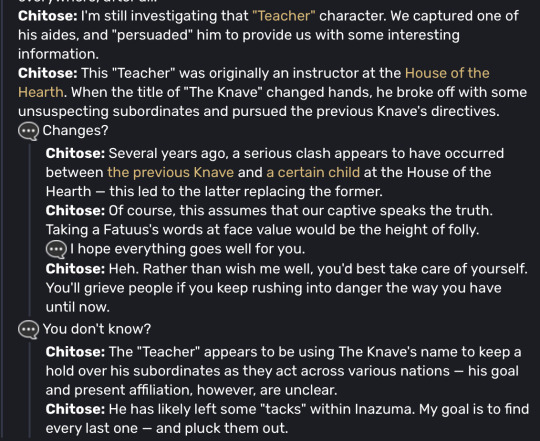
It’s also mentioned he’s employing this plan in an attempt to “rebuild the prestige of the Knave” following Signora’s death, iirc? Now, see, the dialogue itself says that this is “assuming our captive is telling the truth” so who knows what’s really going on, but I find this a really odd/interesting thing to highlight. I’m a bit fuzzy on other world quests with Hearth members, and am not saying none of them were acting and subsequently being treated poorly by our Arlecchino, but like, this gives me a lot of questions especially when paired with implications this previous Knave seemed to be way worse
Like, what drove Arlecchino to take over? How unexpected and controversial was this within the House? Assuming the above information is all true it definitely says something this guy went rogue and acted on what the previous Knave would want and didn’t think our Arlecchino would greenlight it, which does feel consistent with the previous Knave being described as basically worse & crueler than our Arlecchino. It also makes me question how much house of hearth things we’ve seen outside the main story are the work of our Arlecchino or if there’s a bigger divide of loyalty. Heck, I could be wrong but it doesn’t even seem like we know if the previous Knave is dead or not
This isn’t me saying Arlecchino couldn’t possibly be treating hearth children worse than she wants us to know, especially ones who aren’t her “favorites” the way the fontaine trio seem to be, but I really don’t feel sure about making a solid conclusion of her exact level of malice the way ppl r generally understanding it rn when it feels there’s going to be more about her. Just the idea of she, as a Hearth child, clashed with the previous leader who was known for being cruel, overtook their position and took on less harsh methods of leading that made at least some members with more power/possible closer proximity to the previous Knave go rogue and try to commit atrocities in the previous Knave’s name…I feel this leaves a lot of room to suggest there’s more going on with how Arlecchino is as a person
I don’t mind if she’s just very evil and deceptive bc if she totally had me fall for thinking she was less evil than she actually was that’s fun tbh. But I feel people suggest that’s all her character could be with no degree of like, “sympatheticness” or deep grey morality and that if her character did go there it would be automatically poor writing and genshin walking back on making a truly evil woman when IDK. I feel you can claim at this point they have left it open ended and it’s never been completely confirmed she’s pure evil. Also sometimes I just get a hunch and feel cautiously confident in Genshin executing certain characters well. Not all characters, just certain ones. Especially given Fontaine’s character writing being very good and a character like Lyney feeling very solid to me when any development with Arlecchino would likely involve him and his siblings as well, I honestly feel open to the idea of Arlecchino being satisfyingly written to be both villainous/morally dubious but “sympathetic/likable as a person” in ways outside of just her ruthlessness if that makes sense
If I’m wrong/they drop the ball with it more than I anticipate I’ll eat my hat but I am pretty excited about her character and which way they decide to go with it. I will say the only potential impression I have of where they’ll go with her has been wondering if it will go in a “cycles of abuse” direction—I’d be surprised if they ever elaborated on Arlecchino’s character especially in how she feels about things and her also growing up as an exploited child of the hearth wasn’t relevant
#arlecchino#see my track record with said hunch with when I feel I should let genshin cook has been#for months truthing my vision of xiao’s speififc brand of internalized dehumanization induced suicidal ideation#and how genshin will one day he will get another quest of sorts thst develops his character towards#the idea he’s allowed to live and enjoy people’s company and this will likely#also come with following through on yaksha lore and when they do this they will do him SO well and it will be peak genshin quest#all of this Months before the existence of perilous trails was even rumored#and then I was soo stubborn xiao would show up in 2023 lantern rite w more character introspection to follow up PT#and also from the first fontsine teaser I was in the trenches for furina bc I felt so confident#the main storyline would handle her very well & if genshin went anywhere near the direction of her#not being a ‘true archon’ & ppl were Wrong if they thought genshin woudlnt take her seriously#and HAHA. WWOOWOOWOWOEOEOOEOEE#I have also been sent into hysteria multiple times bc genshin keeps canonizing my exact ideas of my favorite character dynamics#and often exceeding my expectations that I thought were jsut wishful thinking#yes I predicted exactly how xiao would interact w Venti & zhongli on screen yes I predicted#the exact nature of hat radish friendship no I was wiped out on the floor#by nahida enrolling wanderer in college & calling him hat guy & zhongli saving xiao’s life#& xiao having hardcore social anxiety from zhongven flirting with each other st the dinner table#this sounds so conceited. see I often don’t know What genshin is cooking but k feel sure in knowing when soemthing is going to be#a shitshow or mediocre or when we need to let them cook. even if it takes 6+ months#TRUST ME <— guy who has been waiting on genshin to cook for several characters for multiple years and is still sure I will get my food#am I crazy. yes. am I also often right when I have hunches on when genshin is going to suck and when it’s going to be good esp character#writing wise. often yes#one day I will annihilate genshined impact with my bare hands#genshin#fern.txt#fandomferns
70 notes
·
View notes
Text
[3.3]: On Dreams, the Abyss, Forbidden Knowledge, and Wish Fulfillment
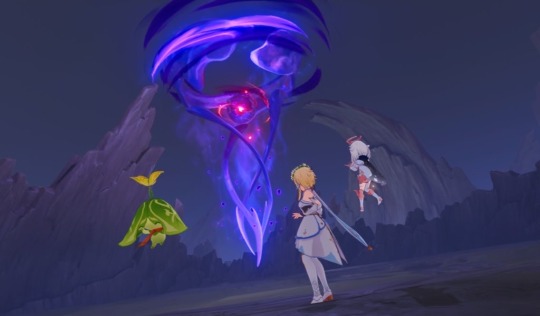
So basically I was reading for another theory about automatons and the uncanny in Genshin, but ended up with some separate-but-related ideas that grew legs and a tail and is now this post. Today I’d like to discuss how Freud’s psychoanalytic theory of dream interpretation provides a framework to help us understand what the Abyss is, what Irminsul edits do to reality, and what forbidden knowledge might be. If you are not caught up on the 3.3 Interlude Archon Quest (Inversion of Genesis), Nahida’s Story Quest, Aranyaka, or Perilous Trail, do not read any further!
(As a side note: I will be simplifying Freud, but I hope that in the process I am not butchering him. Corrections on how the information is presented and applied are welcome!)
Psychoanalysis 101 - On Freud’s Theory of Dream Interpretation
Though it may seem unrelated, in order to begin to understand Freud’s conception of dreams it is actually useful to start with his theory on the psychology of errors. This theory is more commonly known as the “Freudian slip,” the accidental voicing of an unconscious thought often (though not exclusively) through substituting one word for another.
Freud believed that errors occur when two different tendencies “collide” with one another in the process of communicating. The error is not a result of the interrupting tendency triumphing over the other, but is rather the compromise produced between the two tendencies in their collision. For example, I’m talking to someone I don’t particularly like and have to express some politeness to them, but my sentence comes out wrong and includes a more hostile word than I originally intended - the error betrays that my true feelings are not amiable toward this person, but the error in and of itself is not the true expression of my feelings, just a hint toward them.
Importantly, you do not have to be consciously aware of the thought or feeling that produces an error such as in the above example in order for the error to exist. We don’t even have to acknowledge that thought as our true feelings in order for it to serve as the error’s origin. As a psychoanalyst, this angle is crucial to Freud. The unconscious is the realm of the repressed, and to psychoanalysts it is where our most honest thoughts and feelings reside. I don’t have to acknowledge to myself that my feelings towards someone are less than positive for those negative feelings to still exist. I can even actively deny those feelings, suppressing them in favor of less critical thoughts. But I can’t just delete my feelings - they persist, festering in my unconscious mind.
Having understood this, we can approach Freud’s theory of dream interpretation with some important context and clarity. He theorized that dreams work very similarly to errors, in that the dream is the result of an interrupting stimulus or stimuli acting upon the body’s “tendency” to sleep, and the dream is a compromise between the two tendencies in order to protect sleep. Freud acknowledges the way that external stimuli such as noises manifest in a dream, but focuses his theory on the internal stimuli that act on the sleeping body in a hope to disturb sleep – namely, thoughts and feelings, most of which are repressed by our unconscious. Freud also acknowledges somatic stimuli as interrupting sleep, but does not elaborate on them in his theory of dreams.
Freud believed the manifest dream content, the images that you’re shown in a dream, are a result of the latent dream thought, the unconscious thought disturbing your sleep, being transformed by the dream-censor through a process known as the dream-work.
The dream-censor disguises the latent dream thought in the manifest dream content, distorting it’s true meaning to the point that is unrecognizable. At least, in dreams that do not fall under what Freud called infantile type dreams (and we’ll discuss this type in just a minute). So, the dream-censor protects the ego from the unconscious thought through distortion. In order to arrive at the true meaning of a dream, the dreamer must freely associate the manifest dream content with other things in order to decipher the distortion and identify the latent dream thought. With me so far?
Freud also thought there were different types of dreams, one of which is the infantile dream. These dreams have very little distortion between the latent dream thought and the manifest dream content, though distortion is still present. An example he gives is of a little girl who dreamt of sailing a boat on the lake - she had sailed with her family the previous day, but their time sailing ended before she would have liked. The latent dream thought behind her dream, then, was “I would like to sail on the lake,” transformed into “I am sailing on the lake” in the manifest dream content. Freud thought infantile dreams held key information about the nature of dreams in general, which he hypothesized was wish-fulfillment. He believed that wish-fulfillment was central to all kinds of dreams, even what he called anxiety dreams, but that this idea is most evident when examining simpler dreams with little distortion. In the case of anxiety dreams, he asserts that they cause an anxious feeling precisely because the wish underlying them is one that we reject and repress, but it is so strong that the dream-censor fails to censor it fully.
We’re nearly done here, but this last idea is very important. The dream-censor effectively rejects the wishes and thoughts dredged up from the unconscious again by transforming them in the dream-work into something unrecognizable. Freud then asks, well, why is it that these rejected wishes only express themselves at night? Freud hypothesizes that the mind’s censorship is strongest during the day, but at night the censorship is “suspended, or at least very much weakened” (229) in favor of sleep, allowing these wishes to express themselves at all.

Aru: They are what the Jibashiri call the Shades of Tokoyo. But bear in mind the principle that “to know sin is to be free of it.” Do not tell them that they are afterimages.
So, let’s summarize this:
Freud thought dreams are a compromise between continued sleep and stimuli that would otherwise disturb sleep.
He maintains that when the stimulus is mental, it is dredged from the unconscious and censored into illusions that obscure the original meaning of the thought to protect the ego and make the thought incomprehensible.
He also thought that behind this mental stimulus is a wish seeking fulfillment, which is partially accomplished through the dream.
However, the dream cannot truly resolve the wish. The thought, therefore, persists in the unconscious until it is worked through in the conscious life (like through talk therapy).
Rejected wishes express themselves at night because this is the time the censorship is weakest.
While Freud’s theory is far from watertight, and the following applications to Genshin will also not be 1:1, I hope this can be a useful tool in some cases for trying to understand some of the concepts discussed in the intro. Without further ado,
Theory #1: The “chaotic space” beneath the Chasm behaves like a dream.
Now, I very well could just refer to Paimon’s dialogue in Nahida’s story quest stating that “dreams are chaotic,” then refer to the repetition in Perilous Trail of the term “chaotic space” and call it a day, and frankly I think there’s sufficient supporting evidence in the rest of Nahida’s story quest and Aranyaka to render this an acceptable choice, but I also think it’s useful to review all of the ways the space beneath the Chasm does reflect a dream space according to Freud’s theory of dreams, if for no other reason than to extrapolate these findings to other quests.
From the minute that the Traveler, Paimon, Yelan, Yanfei, Itto, and Shinobu fall into the chaotic space, things are not quite right. They notice that their sense of time past differs significantly amongst each other and their bodies seem to be in a “suspended” state, not accumulating fatigue or hunger. What’s more, some of them report strange sightings - fissures that appear and disappear, items that vanish, people that vanish. Illusions. They even stumble upon a strange room after falling through a fissure that shows them an unpleasant or anxiety-inducing thought specific to them, one that they all would “wish to avoid.” What’s going on here?
“All the things that we wish to avoid.”
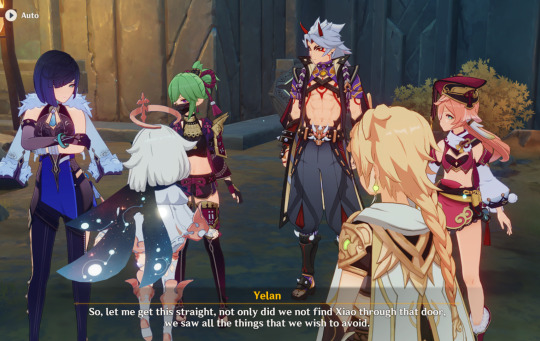
Let’s start with the strange room, and interpret the illusions as if they were dreams. We may not be convinced at this moment that these are in fact dreams, but let’s see what happens when we try fitting them to Freud’s theory. In particular, we’re looking for “manifest dream content,” which we will help translate into a “latent dream thought” with the help of the dreamer, and through this we should be able to identify some kind of “wish.”
Itto’s illusion is Inazumans throwing beans at him and berating him for his influence on their children. This illusion could represent a real memory of Itto’s - one of the NPC’s is named, after all - but he never identifies who these people are to him beyond their Inazuman heritage, so there is no way of knowing if it is an identical memory or not. Still, let’s apply some Freud here and interpret the scene, treating it as an anxiety dream due to Itto’s reaction to it: The manifest dream content, the Inazumans throwing beans at him, represents Itto’s desire to avoid the ire of humans. Indeed, he greatly fears it. The latent dream thought behind the manifest dream content, then, is Itto’s wish to befriend humans and live a carefree life. Despite this sincerity, he is often met with animosity from people other than the Arataki Gang and the children of Hanamizaka. Itto’s wish to befriend humans causes him fear to admit, even if that fear is unconscious, because the scene from the manifest dream content is what he is so often met with in real life.
Similarly, we have Shinobu’s illusion. Importantly, Shinobu only claims familiarity with the conversation her mother’s illusion is having with her, and not exactly with the scene itself. This is a hair-splitting point for me to make, but I hope if you’re not convinced now that after the next two examples it will seem more plausible.
Yanfei: Your mother wanted you to become a shrine maiden?
Kuki Shinobu: The whole reason I came to study in Liyue was because I didn't want to become a shrine maiden. My family never approved of my studies, so they wanted me to work in the Grand Narukami Shrine after I returned to Inazuma.
Paimon: From what we know about Lady Guuji, it seems being a shrine maiden is a pretty cushy job.
Kuki Shinobu: Think of it this way: Some cats can be domesticated and kept in the house, while other cats are meant to survive in the wild... As for me, I need complete freedom and space. Although I do admit that being a shrine maiden is a decent job, it's just not for me.
From this excerpt, I would guess that Shinobu’s wish and latent dream thought is as she says: she wants to live her life freely and pursue anything that interests her. The manifest dream content demonstrates the anxiety that her conviction in this wish causes her through the resistance she faces from her family members as a consequence.
Yanfei’s illusion is where things start to get interesting. She sees people having a civil dispute, something she often has to deal with in her profession as a lawyer:
Paimon: Who were they?
Yanfei: No one in particular, but it is a prime example of the many difficult civil cases that I've had trouble handling before.
Yelan: Hmm, so you mean you don't like handling disputes over petty matters?
Yanfei: Not exactly, what I mean is that I don't like working with people who cannot let go of trivial grievances, especially of the kind you saw just now. They start with good intentions, but end up making a big fuss...
She then states that her motivation in pursuing this profession is to help people solve problems, but that people like those in her illusion are difficult for her to comprehend. Her wish is to successfully navigate difficult legal terrain to help her clients, her anxiety is that she is not equipped to do so because she can’t understand everyone’s “complicated minds.” Put in more Freudian terms, the fact that Yanfei strongly wishes to solve people’s problems as a lawyer despite knowing she finds some minds particularly incomprehensible causes her some anxiety.
Finally, we have the Traveler’s illusion. It is nothing but the vast Abyss. The Abyss that took their twin away, who they are always searching for. We know intimately that their wish is to find them, and their anxiety is that they never will, that this journey of theirs is pointless - hence the twin’s lack of presence in the illusion.


Yanfei’s comment that her illusions were no one in particular also makes me suspect that the previous NPC’s identities are less important than the ideas and thoughts they are representing. The scenes are not the reenactment of a memory, but a distorted illustration of a unconscious thought. Where these illusions at times do not line up with Freud is that the dreamer’s wish is not repressed but is in fact something that the dreamer is actively pursuing in real life. If the wish is not repressed, perhaps the doubts and anxiety associated with them are. Regardless, both seek expression through the illusions, with varying amounts of distortion.
Are we at least receptive to the possibility that these illusions are more than just tricks the space is playing on the crew, that there are wishes underlying them that are specific to each person and draws from both the conscious and the unconscious? If so, I would like to propose that this room did not just show illusions of scenes specific to the people opening them, but dreams.
“Reading our minds.”
Now, let’s deal with the other illusions outside of the strange room. The chaotic space is demonstrably manipulative in how it interacts with each of them. While looking for Xiao and a way out, it projects an odd illusion of him and his voice through a fissure to lure the crew to the dream room. Yelan reports seeing illusions of catalysts specific to her clan and of people when she was there to find the truth about Boyang’s fate. Yanfei also notes that “the chaotic space” is really a misnomer, as it is really several spaces that constantly intersect with one another and can be directly influenced by their own mind’s wishes. They are not completely at the space’s mercy, in other words.
Remember how Freud thought that dreams were a vehicle for wish-fulfillment? It turns out that everyone who makes it to the deepest levels of the Chasm’s illusions also had a deeper purpose for being there: Xiao wished to find Bosacius, Yelan wished to learn the truth about what happened to Boyang during the Cataclysm, Yanfei wished to find the Fantastic Compass, and the Traveler is always wishing to find their twin.

Yelan: This is a long shot, but it may be our last chance…so, whose wish was it that summoned this device?
Traveler: Perhaps it was all of us.
In this deepest part of the space, all of these wishes are answered. While the space undoubtedly had an ulterior motive of trapping them further by using their wishes as lures, the facts remain the same - by stumbling into the last domain after Itto breaks another illusion along the cave’s walls, they’re able to make contact with several phantoms of the Fantastic Compass, allowing them to navigate to the correct time-spaces to get closer to what they all wished to find. I haven’t read too much on this topic, but my first thought is that this is similar to what it might feel like to have a lucid dream.
Yelan gets her answer about Boyang, Yanfei finds the Fantastic Compass, Xiao learns Bosacius’s fate, and the Traveler is cruelly tricked once again with a phantom of their twin in a time-space that resembles the Abyss. Though the space does effectively “fulfill” their wishes with the added direction of the compass, are the answers what they truly wanted? Did it give them peace, or did it serve to lower their spirits again?
Yelan: I went back to the domain again just now. Although I couldn't find a new route, it wasn't a completely fruitless trip.
Yelan: My clan has practiced magic for generations and has created some catalysts that only we know how to use.
Yelan: I recognized something like one of these catalysts in the domain. Unfortunately, it disappeared as soon as I approached it.
Traveler: Was it an illusion?
Yelan: I think so. But it's hard to distinguish between reality and illusion here. I can't be sure.
Yelan: Also... I am the only one out of all of us who could know what it would look like. To me, that confirms that this place really is reading our minds.
Yanfei: Just like with that door. It's like it's alive, and testing us.
Yelan: By reading our minds and showing us what we want, it creates the reality that we want to be true... Everything it does is either to get us to lower our guard or to wear us down.
Yelan: If that's the case, it can only have one goal: To trap us here until we die. What else could it be?
I would make only one amendment to Yelan’s comments here - the space is not just reading their minds, it is their minds. It is their shared dream. It projects illusions using everyone’s memories, unconscious wishes, and conscious thoughts. The illusions are a result of these thoughts interrupting the space’s influence. Their purpose is to draw the dreamers in further, luring them deeper into the space so it can continue its tendency to consume their souls.
Without speculating too much off the deep end, it is clear that the chaotic space traps souls and is capable of holding physical objects taken there, though those objects are no longer able to be taken out. We see this from the notes Boyang and the other Millelith soldiers left behind, as well as from the Fantastic Compass. Clearly, none of these items belonged to any of the people in the Traveler’s crew, so the space must continue to exist regardless of someone’s physical presence within it. I would speculate that the reason this is the case is because the chaotic space is sustained by the souls it consumes. Yes, I mean to say that the chaotic space is also the shared dream of all of the fallen soldiers, of Bosacius, and of Boyang. They are all still “there” in the space, wandering as lost souls, as Xiao implies of Bosacius during his fight with his illusion.
Escape from the Depths

Let’s wrap up this theory here, because we still have a lot of ground to cover. I’ll conclude with some remarks on the red specter-forms that try to prevent the team’s escape from the space at the end.
There is an achievement after the conclusion of this cutscene titled Layers of Fear, which I believe provides a hint at what these specters are supposed to be. If we at least partially accept that the chaotic space behaves like a dream, and that in order to conjure the images characteristic of manifest dream content the space would also need to have access to the dreamer’s unconscious in some way, then these specters are the raw embodied form of the fearful thoughts of everyone trying to escape (to say nothing of how they could also belong to the souls consumed in the space). They are trying to drag them back down into the depths, a symbol of the unconscious where repressed anxiety and fear fester. In the next couple of theories, I’ll make some guesses as to what this means on a broader scope.
Theory #2: The chaotic space shares characteristics with the Abyss, but is not quite the Abyss.
In the last theory, we briefly touch on the possibility that the chaotic space is a shared dream space, and that it is sustained by the souls it consumes. The next question would be, if this were true, then what comes first? The dream space or the soul? How did the space come to be? While I don’t have a definitive answer for that, I do have another rabbit hole we might jump down based on Katheryne’s dialogue in Requiem of the Echoing Depths, the last time that we saw Dainsleif. As she bids us farewell before heading to the Chasm, she recites the Adventurer’s Guild slogan before pausing at “abyssosque,” remarking that “this time, you truly are bound for the abyss.”
So, let’s pause. The Chasm was Liyue’s frontline against the abyssal monsters’ invasion from the Cataclysm. According to the legends, the monsters came “from the depths,” and the deepest part is outright referred to as the abyss in several instances in the Solar Relic of the Vermillion Hereafter set. So, why is there any need to make a distinction between the space and the abyss, or to be skeptical of equating them?
First, the space doesn’t really behave similarly to Dark Enkanomiya in the Three Realms Gateway Offering event, which was being polluted with void energy from the Void Realm (the Abyss in a fancier font). It certainly does try to take advantage of your fears, a tactic we saw an Abyss Herald try to use in Andrius’ corruption ceremony (though Abyss Heralds are of the Abyss Order, distinct from the Abyss, corruption affects anyone who comes into contact with the abyss).
Abyss Herald: You claim to be a guardian, yet your once-sharp claws have clearly dulled since your days of godly glory.
Abyss Herald: If you serve us, we can restore your divine powers you once held in the past.
Boreas: Lies... lies…
Paimon: Oh no... Is this the same thing they did to corrupt Dvalin's mind?
Time also functions differently in the chaotic space compared to on the surface, something we can also trace to the Abyss from Childe’s lore - he spent three months in the Abyss with Skirk, but only three days had passed on the surface. But, if the chaotic space was the Abyss, I am not sure why Yelan wouldn’t have commented on the space’s similarities to it sooner. The only time she mentions the abyss is in the deepest parts of the chaotic space, when the Fantastic Compass’s needles are pointed forward the farthest they can go and the Traveler sees an illusion of their twin that turns into a smaller Fantastic Compass. Yelan knows the Abyss well from her own past, so it’s weird that she didn’t mention anything until close to the very end in a specific place.
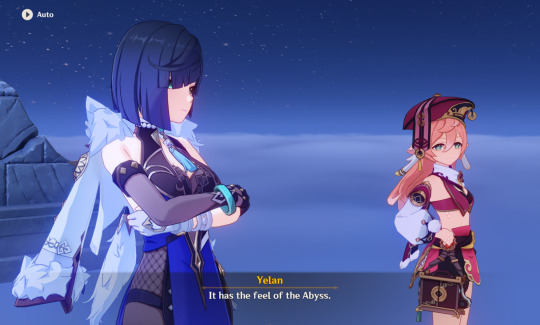
So, what about a middle ground? The space shares characteristics with the Abyss because it is a boundary, a liminal space, between the Human Realm and the Void Realm. A place where the two realms “interrupt” each other, much like the way dreams are a liminal space between the conscious and the unconscious, much like an “error” produced when two different tendencies collide.
Theory #3: The spaces below the earth, including the Abyss, are this world’s “realm of the repressed.”

The Thing Calling Itself “Enjou”: You mean, why wouldn’t I, right? I’m a creature writhing in the Abyss, and you’re a mortal walking in the sun.
This mini-theory definitely has its issues from the get-go, but let’s take a look at where this does ring true and then decide for ourselves how much weight this claim really holds. We’re also going to stretch the meaning of “repressed” here to deal with more than just unconscious feelings, but also beings and structures. Ultimately, we’ll see there’s not as big of a difference as imagined between these things and repressed feelings.
“Yet buried in the depths of this world lies smoldering remains…”
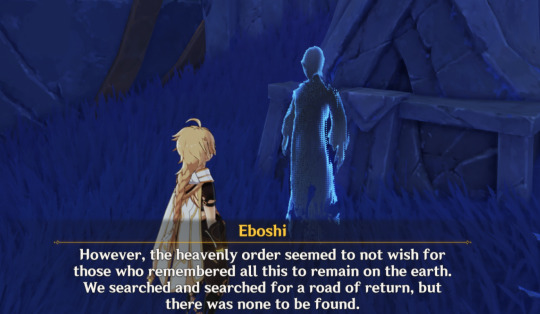
Eboshi: However, the heavenly order seemed to not wish for those who remembered all this to remain on earth. We searched and searched for a road of return, but there was none to be found.
In the beginning, the Primordial One vanquished the Seven Sovereigns and banished the Vishap race to the depths so that it could create a world suitable for its creation, humans.
Later, a second divine throne would descend to Teyvat and war with the Primordial One, who dropped the celestial nails to stabilize the “delusions and breakthroughs” arising in the mortal realm due to the “illusions” brought forth by the invaders.
In laying waste to the mortal realm, the ancestors of Byakuyakoku fell into a space below the earth and were banished from returning. There they met hostile creatures, the “Dragonheirs of the Depths,” who had lived in darkness since their defeat during the mortal realm’s creation. The two struggled against each other until the construction of the Dainichi Mikoshi and its artificial sun.

Eboshi: Due to the phenomenon known as Sinshades, the “past,” “history,” and “truth” of Enkanomiya would endure even if left to their own devices. As such, great effort was expended, not that we might remember, but that we might “forget.” Lady Sangonomiya was of this view.
Another such civilization’s ruins can be found deep within the Chasm, the nameless upside down city, but still more vanquished civilizations can be found in these spaces below the earth: the mural civilization of Tsurumi Island, the Ruins of Dahri (a Khaneri’ahn ruin), and the list goes on. Of those listed here, all were privy to truths of the skies that the Heavenly Throne sought to conceal and suppress. All of them had something to do with forbidden knowledge contamination events.
To return to the topic of Vishaps, the “return of the repressed” is also illustrated by a particular progression in 1.x patches with the Geovishaps and the Primo Geovishap. Prior to version 1.3, the Geovishap overworld enemy did not exist. There were only Geovishap hatchlings, which also had a slightly different appearance before 1.3.
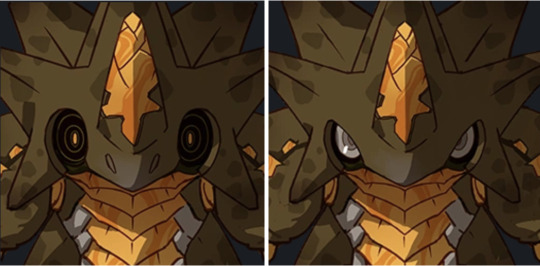
Pre-1.3 (left) and current (right). Notice the major change that occurred was in the eyes. The one on the left may be a newly resurfaced vishap hatchling with eyes still designed for below surface light levels, while the right one has adjusted to the change in light.
From the Geovishap archive:
It is said that after many years have passed, Geovishap Hatchlings will shed the armor that originally protected them and become Geovishaps. However these two and the older, greater Primo Geovishaps have spent many years hibernating under the mountains and have only emerged and become active in recent times. As such, none can personally attest to have witnessed or recorded such a thing in person.
And the Primo Geovishap archive entry:
Folktales hold that after the great "draconic calamity" that led to the ruination of Tianqiu Valley, the overlord of the Geovishaps and Primo Geovishaps was imprisoned deep beneath the earth, and so too did they burrow into deep and unseen places, awaiting their chance to rise once more…
This description is referring to Azhdaha’s imprisonment beneath the Dragon-Queller tree. Azhdaha debuted as a weekly boss in version 1.5, two patches after these Geovishap enemies were released and changes were made to the hatchlings’ appearance. Azhdaha’s own circumstances are no exception to this theme of recursion either - Morax found him beneath the mountains, befriending him for some time before having to seal him away underground once more. In version 1.5, he returns once more to break the seal on his tree and rise to the surface again. Azhdaha is at once two things: he is his own suppressed rage at the ley lines’ exploitation, and he is symbolically the repressed pain Morax endured in sealing his own friend. This will hardly be the last time they will suffer this pain, Zhongli knows. The repressed will return again. Hoyoverse demonstrated this phenomenon through their patch release schedule in a way I would wager was quite intentional, to gesture towards the “feelings” that were slowly bubbling back to the surface.
This is just a smattering of examples in a long list of cyclical recurrences, but I’ve gone on long enough. The point is that, with the notable exception of Sal Vindagnyr, the things this world suppresses are often found beneath its surface. They are things that this world would prefer to forget, something unpleasant that it would rather avoid.
Theory #4: Dreams, as liminal spaces between the conscious and unconscious, are a frontline for delusion and corruption.
Here I want to further explore the implications of a chaotic space like that beneath the Chasm behaving like a dream space, and that space’s behavior sharing characteristics with the abyss. To do this, we need to take another look at wish-fulfillment in dreams, delusions, and corruption. Here we have to fully embrace the analogy of the surface as the conscious mind and the Abyss as the unconscious mind to make necessary progress.
Seeds of Delusion
"We share the same goal, you, your Tsaritsa, and I."
"Cleanse the sources of distortion in this world: short-sighted, ignorant gods and the darkness and corruption of the Abyss." –Stainless Bloom, Pale Flame
Nahida’s first story quest is crucial to understanding the significance of dreams as sites for repressed wishes to be expressed.
Take the humorous first dream question Paimon is asked at the dream event. Ata finds his daily life difficult, so he wants his dreams to be a space of leisure where he can reliably “become” a Slime as relief. Paimon details every time she has dreamed of the same thing, but every dream ends the same way: tragically. This lays the groundwork for the rest of the quest quite nicely.
Each dreamer has an unfulfilled wish that causes them great sorrow, and that can never be fulfilled in real life again. Their dreams are the only place these wishes can be fulfilled, so they retreat into the dream world where the illusions of the manifest dream content can comfort them through pain. This is a prime example of how wishes can become obsessions, and how obsessions feed delusions. This is what it means to “become” a monster.
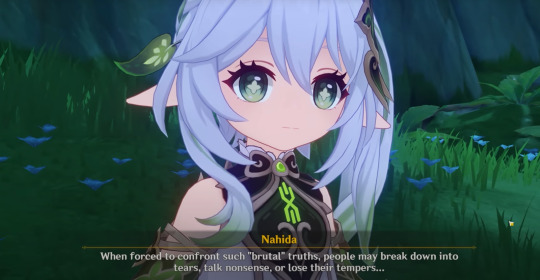
Nahida: When forced to confront such “brutal” truths, people may break down into tears, talk nonsense, or lose their tempers…
But this can only end in tragedy. Because dreams, ultimately, are illusions, and fulfilling a wish in a dream is not the same as fulfilling it in real life. Underneath the manifest dream content of all those who wish to escape reality is a latent dream thought that causes the dreamer terror. For Ilman, it is his wish to be with his wife and the repressed terror of never being able to do so again. Once the mantle of the dream-work from Beynuni (who functions as the dream-censor here) was pulled back and the dream collapsed, these anxious wishes all took the form of monsters - riftwolves, lawachurls, geovishaps.
Ata: I guess I just want to experience something different. My everyday life is nothing but the same…The sky is right above me, and the ocean just over the horizon, yet I remain caged in a life of monotony.
More than this, the underlying wish reveals something far more sinister in these dreamers, and that is a dissatisfaction with reality. It is this dissatisfaction, the horror of reality that welcomes delusion and Abyssal influence in the mind. Once it has taken root, “forgetting” becomes much more difficult. By blurring the lines between dreams and reality, the dreamers also introduced monsters near the site of their delusion in the real world. Maybe this is one of the consequences of trying to reject the truth?
The Forest Will Remember
Traveler: Do we need to enter the dream of the Vasara Tree this time too?
Arama: Yes. We must erase all traces of Marana's influence.
While dreams are not the only place where anxious thoughts can bloom into delusions and obsessions, they remain a key site for the beginnings of delusion and also for the forgetting of delusion. This is crucial to Aranyaka, which deals in memories, dreams, and the repressed trauma of lost innocence.
In order to save Rana from the influence of Marana’s Avatar, we have to help the Aranara save the forest from its influence as well. Marana is the memory of death in all things, reborn each time it resurfaces in the conscious mind.

Araja: The forest didn’t know death, until a day came when the trees realized that withered flowers and dead animals covered the earth.
Araja: On the same day, the earth remembered the dark, poisonous blood it had once devoured, or was about to devour. The rivers thought of the descent of the sun, evaporating all water and leaving a red world behind.
Araja: They realized that all things would meet their end, and so, Marana was born. It is the name of death, and those who know it shall die.
Araja: Marana urges everything towards death. As for the tall, dark, and warped beings, they are the avatars chosen by Marana, the heralds of death.
Marana’s influence spreads in Sumeru through Withering Zones as a consequence of forbidden knowledge polluting Irminsul. Tighnari notes early on in the Archon Quest that each eradication has a shorter latent period between resurgences. This is further reflected in Aranyaka by the many dreams we enter to “erase all traces” of Marana’s influence, because taking care of the Withering Zones outside of these affected plants is not enough to get rid of it.
Arama: Alright, Marana's influence should be right inside. If left unattended, it will soon turn the dream into a horrifying nightmare.
Arama: If we take care of the baddies inside, the Vasara Tree will become healthy again and thank us with a Vasoma Fruit.
Marana’s influence in the Vasara Tree takes the shape of fungi, perhaps in the Traveler’s dreams it takes the shape of an Abyss Herald. By eradicating its shadow in the Vasara Trees’ dreams, we help the Vasara Tree “forget” Marana so that it can produce a Vasoma Fruit with memories and dreams that are free of it.
Inherent to Araja’s definition of Marana is the return of the repressed. When the forest learns of death, it remembers “the dark, poisonous blood it had once devoured, or was about to devour.” The memory of Marana resurfaces, thus Marana is born again. Once it is repressed through the process of “forgetting,” the cycle starts over. This is not the first time that the forest learned of death, and it may not even be the second time. The source of the forbidden knowledge pollution event was King Deshret, after all. Didn’t that disaster occur before the Cataclysm? Oops, I forgot the initial pollution seemed to only affect the desert. Ignore this point.
But wait, Tillandsia! If you complete Aranyaka after completing the Archon Quest, the dialogue suggests even repressed memories can’t return anymore once they’re removed from Irminsul!
Arama: Yes. May we never meet again, Marana. Many tiny Marana remain in the forest, but we've defeated the greatest one.
Arama: I can sense that all memories about Marana in Sarva have been completely erased. In this case, even the memory and fear of "death" that dwells in all things cannot bring it back ever again.
Despite the temptation to bow to Arama’s words, we know this isn’t completely true. We’ll explore those loopholes briefly in the next theory…
Theory #5: Irminsul Edits as Dream Censorship.
“The tale of the moon goes like this: this story came from a very ancient dream, one that was hidden in a Nilotpala Lotus.” –Moonpiercer
Now, this post doesn’t cover even one tenth of the material in this game that deals with the concept of dreams. If I tried to address every single thing, we’d be here until sunrise and still going on tangents. However, I want to go down one more rabbit hole before calling it a day and moving on to the follow-up of this post.
You’ve probably noticed that many of the early dreams we considered did not suffer from heavy amounts of censorship from the dream-censor. The distortion between the latent dream thought and manifest dream content was minimal, allowing the meaning of the dream to be interpreted rather easily by myself, and in some cases by the dreamers themselves.
But we’re not free of the idea of the dream-censor yet. Its job is to mitigate the expression of the repressed thought in the dream, distorting it to the point that its original meaning is incomprehensible without dream interpretation techniques.
Well, the two don’t work quite the same way, but I couldn’t help but notice the similarities between what editing Irminsul does to reality and how the dream-censor distorts unconscious meaning. Irminsul contains a record of everything that has ever happened in Teyvat, with the exception of anything that originated outside of Teyvat such as a Descender. Nahida is an “avatar of Irminsul'' and has a deeper connection to it, having originated from its unsullied branches. What’s more, we know that Nahida has the power of dreams, a formidable ability in Teyvat that even the Fatui have their eyes on. Given her origins, could this ability also be an extension of Irminsul’s power?
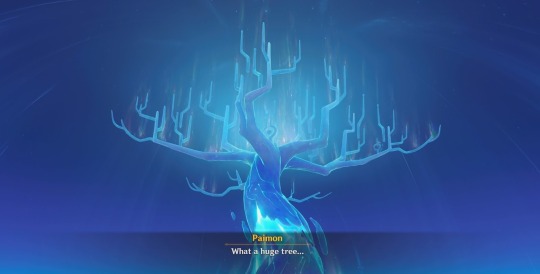
At the end of the Sumeru Archon Quest and in the Interlude Quest, two major edits are made to Irminsul’s records: Greater Lord Rukkhadevata’s name is erased, and Wanderer’s identities “Kabukimono” and “Balladeer” are erased. While these edits had severe consequences for the written and recalled records of the world, spanning from books to quest dialogue to artifact sets to domain descriptions to even character voice lines, we know from Inversion of Genesis that Irminsul deletions do not split any timelines or actually change the events of the past, but merely how they are remembered. Those who died in the past before the deletion still died untimely deaths, those whose lives depend on the consequences of edited events are still alive. Rather than removing information completely, I wonder if a better analogy is that Irminsul introduces distortion into everyone’s unconscious.
No, seriously. Seriously think about what Nahida did to save Wanderer’s past from the deletion. She hid his past in an allegory, and by interpreting that allegory she was able to remember his past, including all of the gaps left in between. It wasn’t a matter of reteaching Nahida and Paimon what the Traveler already knew, they couldn’t comprehend it that way. It was about properly recalling the information by associating each element of the story with something else. Just like a dream. She created her own form of distortion, one that could be more readily understood. Perhaps nonsensical on the surface, there is a hidden truth beneath it. If the analogy holds true, we can locate Irminsul and the Ley Lines in the boundary between the conscious and the unconscious.
The truth is not deleted, and the past is not changed. It is just being repressed.
Conclusion: Nothing Under the Sun is Truly New
Nahida: But in this dream, you showed them only the most comfortable and soothing things. This entire world has been built on a foundation of buried and unseen pain.
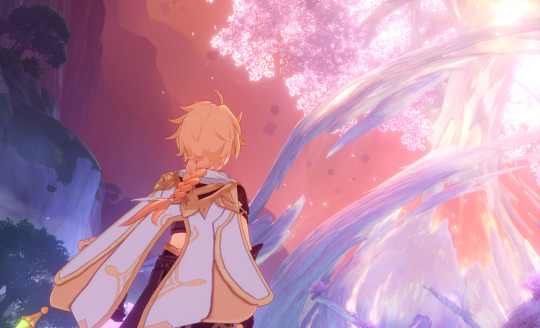
We’ve explored this idea of how unconscious, repressed thoughts recur through dreams by using Freud’s theory of dream interpretation as a framework, and we examined how this framework shows up in Genshin’s worldbuilding (and where it diverges). We’ve shown how becoming obsessed with these repressed thoughts can occur through delusion, and that delusion can take root in dream spaces. We’ve also revisited the ideas presented in Aranyaka about Marana, also known as The Withering, which exists and recurs because of forbidden knowledge from the Abyss that contaminated Irminsul.
With this, I’ll propose an imperfect analogy: the Abyss, symbolic of the unconscious and realm of the repressed, contains forbidden knowledge about the world at its deepest point. Though Greater Lord Rukkhadevata tells us that forbidden knowledge “doesn’t belong to this world,” that it comes from the very bottom of the Abyss, I am skeptical that this is really the full story:
Nahida: So what exactly is... forbidden knowledge?
Greater Lord Rukkhadevata: It's a kind of knowledge that doesn't belong to this world, and a form of "truth" that can't be understood.
Greater Lord Rukkhadevata: The world is constantly rejecting it, leading to all kinds of bad phenomena.
Greater Lord Rukkhadevata: If we allow forbidden knowledge to pollute Irminsul, I'm afraid the entirety of Teyvat could fall apart.
I cannot deny the way Greater Lord Rukkhadevata’s description of forbidden knowledge resembles the psychoanalytic concept of a repressed thought. Note that from Rukkhadevata’s dialogue, the problems that arise from forbidden knowledge seem to be a result of the rejection rather than the knowledge itself. Why is this “truth” being rejected? What makes it unable to be understood? Is this imagined destruction of Teyvat comparable to something like ego death, the destruction of self-identity?
Rather than coming from beyond this world, forbidden knowledge is, I think, more likely to be something that the world has forgotten belongs to it, “something long known and at once familiar,” that has become strange and incomprehensible through repression and distortion. It is something the world is in a cycle of remembering and forgetting in disaster after major disaster as the repressed returns once more. Dreams are crucial sites for its return.
What may be interesting to consider with this analogy is that if forbidden knowledge is indeed a kind of repressed thought that the world has “forgotten,” its recursion should tell us that it wishes to be expressed, and that it is seeking fulfillment in the world’s “conscious” mind. If forbidden knowledge was the world’s repressed wish, what would that mean? Hell, what would the wish even be?
Writing this kinda made me feel like how I felt while reading Freud, so if not everything makes sense or agrees with each other I sincerely apologize and hope there are at least a few ideas here that feel useful, even if just for this moment. Thank you for reading <3.
Sources:
All information regarding Freud’s theory of dream interpretation comes from A General Introduction to Psychoanalysis, primarily lectures 6-8 and 13-14. You may read it online for free at Project Gutenberg.
#genshin impact#genshin impact lore#genshin lore#nahida#genshin theory#sumeru lore#sumeru archon quest#aranyaka#perilous trail#theory#enkanomiya#azhdaha#irminsul#ley lines#don't worry I don't use any weird freudian stuff#he can keep all of that
213 notes
·
View notes
Text
Question:
During the Chasm Archon Quest, a line about five elements and/or nations is said like, three times I think. Why 5. This is bugging the hell out of me.
Also the fact that the hole the crew are in sucks away peoples strength and what not, and it goes especially hard on beings of the abyss. So everybody’s suffering due to the thing, but Paimon’s deteriorating faster than everybody else. Is it bc she’s just Paimon and generally small/weaker than all the others (no vision ect.) or is the game gonna plot twist us later with a surprise Paimon’s from the abyss.
#genshin impact#genshin archon quest#genshin chasm#genshin lore#perilous trail#paimon#paimon genshin impact
10 notes
·
View notes
Text
Tiny self-promotion: Guizhong will know a return, I do so pinky promise it, but Fontaine gripped me by the throat since its release and writing her in and/or around that region is incredibly difficult. And because abandoning my Liyue roots is, well, pretty much impossible for me to do, I've gravitated towards another that possesses one hell of a loyalty to the same region, but also allows me ample opportunity to realistically interact with those outside of Liyue, especially Fontaine.
So, on that note— Yelan can be found here (and if you prefer dashboard view, here).
#[ self promotion. ] more astonishing is that this story has survived this long at all. it appears she has proven herself right once again.#[ she will be getting a little proper promo soon-- but for now; this'll work. ]#[ i like how i had an investment in yelan for gameplay reasons and then i did perilous trail p2... ]#[ i then did her story quest. and i learned her history and well-- here we are. ]#[ and with her history with pantalone; her bracelet; the coat... it gives her a reason to go to fontaine. ]#[ because of childe. ]#[ who has a connection to sir regrator. so here we are. ]#[ don't worry-- guizhong will return. it's just a little complicated at present. but it'll get settled! ]#[ and kafka will also be around again; but fontaine just. like i said. fontaine gripped me. ]#[ it's one hell of a region. ]#[ ooc. ] wherever her spirit may be among the countless grains of sand and specks of dust between the harbor and the mountains…
13 notes
·
View notes
Text
ok sorry i'm going to ship hate again
some things in genshin fandom really just don't make sense to me. ie somehow the most controversial ships at least have canon material, whereas some ships are decently popular but literally only eyecandy with 0 substance. like why are you doing this, they don't even have mutual voicelines or story mentions, they've NEVER interacted, would have 0 reason to even in future storylines, the only reason you like them is because they're lesbians together or smth
yes this is about yan.tao and shen.lan
#open at will: hater behavior#the male ships also don't suffer from this (at least in my experience) so i think it's really just stupidity and a complex about women#i'm also less annoyed about shen.lan because i see it less and i'm more neutral on the two#theyre kind of egregious too though bc they have No voicelines OR mention each other either LMFAO weren't even released in the same patch#but yan.tao DEAR GOD. i can't ever look in the yan.fei tag without seeing them it plagues me#yanfei has one singular voiceline about ht and people immediately thought OMG lets make them kiss or osmething#the fact that it's STILL popular even after shinobu and yelan and especially after perilous trails quest i'm baffled. please LET IT DIE#there are better characters to make her interact with !!! shinobu is literally a goth and purple if you're still looking for eye candy!!!!#and literally gan.yu qianbei also exists if you think long distance relationship doesn't work or something#idk i'm just so annoyed yan.fei is my main and forever has a place in my heart and then she gets crumbs with a ship thats so fucking random#baffles me . ok haterism over i'll reblog normal things now
6 notes
·
View notes
Text
my thoughts on the 2.1 livestream announcement summed up

3 notes
·
View notes
Text
warnings: archon quest "perilous trail: interlude" spoilers
I don’t post my writings often so can you tell how Bonanus has me in a chokehold
bonanus x gn reader “You’re still as beautiful as the day I first saw you. . .“ ৻৲
Bonanus hums a birdsong she had heard this morning, watching as the orange tinted horizon slowly sets into the dark, pallid night. The stars would start making the sky bright, yet all your attention would be on her. Even though you knew Bonanus, as a yaksha, would never be able to live a carefree life, but, at the very least, everything about her struck you as perfect, and it didn’t matter if she said otherwise.
Bonanus chuckles, suddenly hanging her head with red tinted on her cheeks, her claws over her mouth.
“What is it?” You asked her.
“You’re staring. . .”
You take her claw into your hands, holding her dearly, “You can’t blame me, hm?” You said, laughing with a close eyed smile. And yet, instead of hearing Bonanus’ cheerful laughter, you hear her sigh as you feel her other claw cover both your hands.
Your eyes flutter open, being greeted with her smile as she looks at both your hands intertwined with her claws. You could tell something was on her mind. You tilted your head as your grip on her claw tightened ever so softly, a peaceful omen that she knew—she cherished.
Suddenly, Bonanus says, “I wish I could hold your hands as you hold mine.”
You look at her solemnly. Bonanus continues,
“The things I would give to feel your hands interlocked with mine. . . just once. . .”
“You’re still as beautiful as the day I first set my eyes on you.” You say as you hear her voice—as you hear her reasons. Bonanus smiles. She rests her head on your shoulder as she clings onto your hands ever so softly, afraid that if she holds it any tighter, you’ll break. You were so precious to her as she is to you.
Bonanus had told you that her claws were the thing that made her suffer her karma, as it was her weapon in battle. And yet, it still confuses her how you can hold them—how you can hold her—so lovingly.
You placed a kiss on the top of her head.
“I’d trade anything to grow old with you.” Bonanus says wistfully.
“As do I, dove.”
BONANUS LOVES HAND HOLDING AS CONTRADICTORY AS IT SOUNDS SCREW YOU
bonus chapter
author's note I UH UH don't follow if u're gonna mostly expect this lolol this is a dump account (if you follow, you will be seeing my random thoughts on your dash so beware probably) that's also my main account and i do (and will) post my writings here sometimes ok you can follow if u wanna see the bonus chapter and unfollow when i post it 👍
#genshin impact#原神#genshin x reader#genshin bonanus#general chizapus#bonanus#yaksha#archon quest spoilers#perilous trail#bonanus x reader#bonanus x you#g g g g g g general chizapus 😍😍#genshin impact x you#minlin#genshin liyue#genshin lore#genshin impact x reader#genshin fluff#genshin spoilers
91 notes
·
View notes
Text
“idk why, but i just really like the idea of xiao being in the chasm.”
-me, running around the underground mines for the first time, prior to doing perilous trail
#i was all like ‘ooo look at these things that make you jump high those are cool’ until i did the quest#now i just feel bad about bringing him back there#♡⊱a talks#genshin#genshin impact#chasm#genshin chasm#genshin impact chasm#xiao#genshin xiao#genshin impact xiao#perilous trail
11 notes
·
View notes
Text


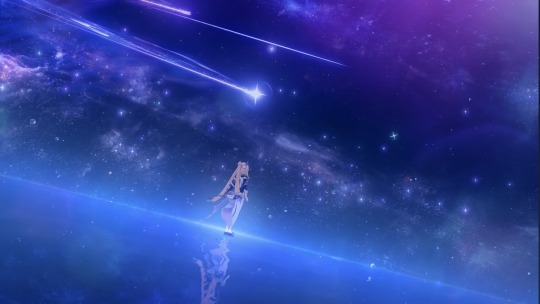

and hoyo, company of motifs and symbolisms, just expects me to believe she's just a normal person. okay, sure................
#mine musings#liveblogging genshin#kokomi in 2024 natlan interlude quest. i believe it (delusional)#natlan aka land of dragons and interlude quest aka post-AQ lore quests#(e.g. chasm/perilous trails and wanderer/inversion of genesis)#well if anything this video at least shows the same sky as the sky in mona's mirage island in GAA#which i think is the 'true sky' or the abyssal sky#and there's the theory that dragons came from beyond teyvat similar to the twins. listen i can connect the dots just listen—#genshin lore
2 notes
·
View notes
Photo

Not sure if anyone else noticed this about the Perilous Trail Chasm quest.
The reflections in the water are all upside-down. This only happens after you go through that initial domain, and then discover that you’re really trapped there. Initially your reflections are normal!
Just something that stuck out to me that added to the whole general uneasiness of the entire situation.
#genshin impact#perilous trail#chasm#the chasm#genshin chasm#traveler#paimon#itto#ushi#yanfei#kuki shinobu#arataki itto#yelan#xiao#This quest was so good it scared the shit out of me
54 notes
·
View notes
Text
Hang by a Thread
from The Shimmering Voyage Vol. 2
Dimeng Yuan, Yu-Peng Chen, Yijun Jiang, HOYO-MiX
#genshin#genshin impact#the shimmering voyage vol. 2#the chasm#the chasm:below#archon quest#cutscenes#interlude act 2: perilous trail#yelan#xiao#yanfei#shinobu#itto#zhongli#plays in the cutscene where they're escaping the chasm and xiao (tries to) sacrifices himself#dimeng yuan#yu-peng chen#yujin jiang#compressed
30 notes
·
View notes